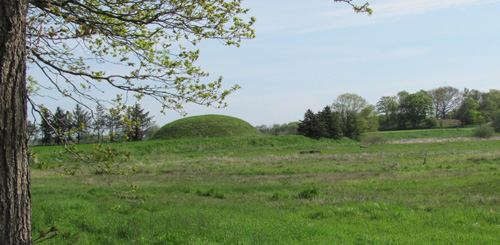Bronze Age Monument Skelhøj
15 km northeast of Ribe is the Tobøl-Plougstrup burial mound group. The burial mounds here comprise the westernmost part of a row of burial grounds along the river Kongeå's north side.
Several of these burial mounds have particularly large dimensions, including Skelhøj with a height of 7 metres and diameter of 30 metres. The burial mound was completely excavated in 2002-2004 as the result of a culmination of a several year long research project on Bronze Age burial mounds.
In recent times, Skelhøj has been subjected to looting, and the remains of the actual tomb has almost completely disappeared. Conversely, the burial mound construction was well preserved, which enabled closer studying of the construction of the monument, which consisted of peat from grassland and moorland areas.
A burial mound is created
Sometime in the mid-1300s BC, a burial mound was constructed over a deceased person at the edge of the Kongeåen's meadow cliff. It was a religious and well-organized piece of engineering.
First, the selected burial mound area was burned, and then the oak coffin was positioned and surrounded by stones. Eight large stones were erected on the edge, so they formed a circle of about 30 meters in circumference. The lines from each stone to the centre of the circle with the coffin represented the section boundaries that should be respected during the construction of the burial mound.
Eight working groups then began the construction of the burial mound, who picked up turf from different places in the surrounding area. These building blocks were laid horizontally with the growth side facing down. Each team had its own transport path to the centre of the construction site.
Water was continuously fed to the turf, and fist-sized stone was laid in radial lines. A mound core of 15 metres in diameter and 3 metres in height was constructed above the oak coffin. Then it was expanded it four times, so that the construction finally reached its full size with a height of 7.5 metres and a circumference of 30 metres.
All around the foot of the mound there was a collar of underground gravel brought that was completed with a boundary chain of stones.
The Sun was God
Bronze Age people apparently worshipped the sun as the supreme deity in their religious imaginary world. Sun-related symbolism can be found in a great number of bronze and gold objects, and not least in petroglyph images.
Skelhøj has truly demonstrated that the burial mounds also contained religious expression. The ground form has the shape of an eight-spoked wheel, the expansions were made in concentric circles, the radially placed stones are shaped to radiate from its centre.
Preserve for posterity
The supply of water helps the formation of a cement-hard iron layer that encapsulated the burial core with the deceased in a moist and oxygen-poor environment. Those left behind probably wanted to keep the deceased's body preserved for posterity
Skelhøj has been rebuilt to its original size and dominates the landscape together with its neighbouring barrows between the villages Tobøl and Plougstrup, where the Danish Agency for Culture has established a cultural trail.
A profile from Skelhøj, where you can clearly see the different turf characteristics, is exhibited in Sønderskov's main building. (Sønderskov Museum Sønderskovgårdvej 2, 6650 Broerup)
Recommended literature on Skelhøj
Mads Kähler Holst m.fl. 2004. Skelhøj. Et bygningsværk fra den ældre bronzealder. Nationalmuseets Arbejdsmark 2004, p. 11-23.
Mads Kähler Holst m.fl. 2008. Cirkler, sfærer, hjulkors og høje. By, marsk og geest 20, 2008, p. 5-14.


